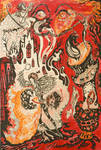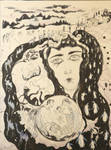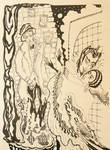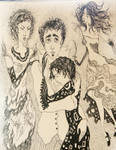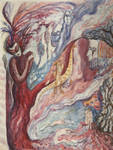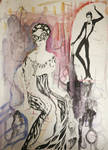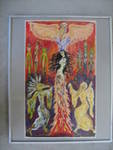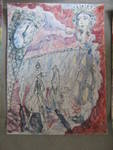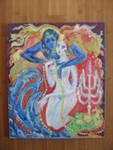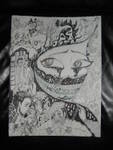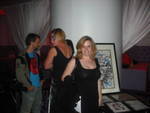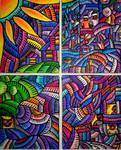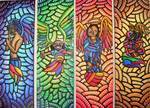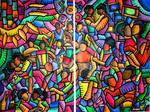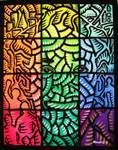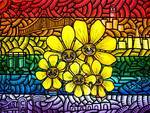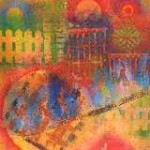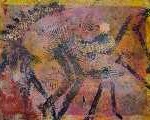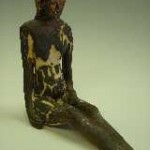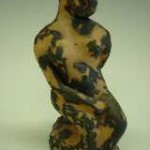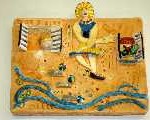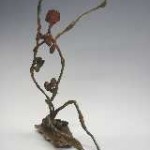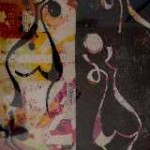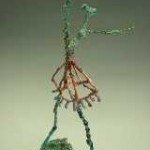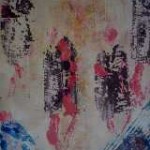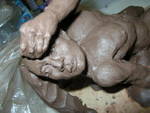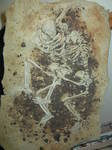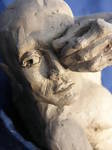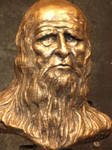Greetings everyone and welcome to June’s issue of Synchronized Chaos Magazine! Wishing you a happy graduation and a lovely Father’s Day, and celebrating the change of seasons with a burst of creativity.
This month, our contributors reach deeply into their knowledge and backgrounds in order to uncover and bring back glimpses of what is beyond personal or collective experience. Together, they present hints of a world beyond our grasp, intimations of the unknown.
San Francisco State University’s Personalized Medicine: Targeting Cancer workshop explores physical unknowns related to medical research, positing that by understanding and classifying individuals, we can put all the pieces together to construct a view of the larger biological picture. Returning essayist Cynthia Lamanna also works to understand human life by moving from the specific to the general, developing a colorful, detailed description of various roles a mother might play in order to uncover and convey the overall concept of motherhood.
Visual artist Mariya Milovidova subconsciously develops her pictures in a similar way. She draws upon and incorporates diverse sources of inspiration, from her Eastern European heritage to nature and today’s current events, into a cohesive style somewhat reminiscent of Marc Chagall – warm and comforting, but with a hazy, faraway transcendence. Her fellow artist Marconi Calindas, the ‘Happy Artist,’ also reflects various geographical influences in his work, celebrating the Pacific Islands and the San Francisco Bay Area through paintings which blossom with vibrant energy, honoring pride, home, and family. Self-described as popular among Russian and Japanese tourists to the Mariana Islands, Marconi and his work can be conceptualized in a positive sense as appealing to people curious enough to travel and see out-of-the-way places for themselves, and providing them with a glimpse into various cultures and our common humanity.
Opera San Jose’s production of La Rondine (The Swallow) bursts into life along with Marconi’s paintings, replete with roses, sunlight, laughter, and parties. Romantic courtesan Magda experiments with the unknown, attempting a trial run of the home and family life denied her as a kept woman, and becomes stronger through the bittersweet end of her rendezvous. Mixed media artist Stephen Mead’s work also emerges from personal experimentation, as Mead develops ideas about intertwined global spiritual truths and respect for other life forms organically, while he works with various materials. He’s figuring out the nature of the metaphysical universe right along with the technical properties of oils, glazes, and acrylics, excavating everything as if from a child’s treasure chest.
Returning artist and writer Reuben Rutledge openly honors the power of art to permit creators and viewers a glimpse into truths beyond our daily existence. As we follow our creative paths wherever they might lead, surrendering to and serving our artwork and our calling, we become participants in the sacred and the sublime, and begin to comprehend the mystery and grace held within even the most ordinary objects and places. Yet, even after many years of mastering his craft, Rutledge acknowledges the limits of our present human knowledge of higher truth. He illustrates this visually through manipulating his photographs to obscure distracting detail and draw attention to the shimmering, joyfully divine essence of the subjects, and dedicates himself anew to the quest for beauty and meaning.
Returning Christian devotional writer Patsy Ledbetter also admits to our limited knowledge of our world, and illustrates how we may draw upon our potential ignorance as a source of encouragement. Struggling as a substitute teacher, she has little idea of the impression she’s making in the life of a student, who will remember her much longer than that school day.
We often find it difficult to understand ourselves and our own motivations and desires, much less outside reality. Hawaiian comic artist Kit Fox renders her personal artistic journey through her black and white strip, intentionally appropriating a ‘cute’ childish sensibility and style of humor. This, combined with Fox’ unassuming self-mockery, and the realistic curves on her human and animal characters, creates a warm, human sensibility which opens viewers up to her relatively honest psychological exploration. Novelist and professor Kate Evans also grapples with self-discovery in her new release Complementary Colors, where the protagonist discovers her need for deep personal and intellectual intimacy with another human being while acknowledging her romantic interest in another woman. The heroine, Gwen, learns not to fear the Merge – becoming truly close to someone else – and to honor and nourish her inner hunger to be understood.
Ilana Davis describes her work in various artistic media as a kind of ‘merge,’ a physical extension of her thoughts, and as a conversation where she responds to her experiences by creating metal and clay figures. Categorizing various materials in terms of their technical possibilities and limitations, she sublimates ideas and emotions into physical objects. Striving for aesthetic grace, she renders intangible concepts more comprehensible, bringing us varied glimpses into a more abstract world.
Sculptor Kathleen A. Ball joins Davis in reaching into the unknown, exploring ancient peoples, technologies, and scientific and cultural value systems. Ball researches and harnesses historical and contemporary, multicultural ways of knowing and describing the world so that those modalities of conceptualizing our universe will gradually seep into her artwork. Creating a figure from a certain time period is an entire philosophical process of entering into the worldview and thought processes of the time to make her work ring true not just technically and anatomically, but in spirit and feel.
While organizing the Beauty Expo, the people of San Francisco’s Fashion and Merchants’ Alliance and Pigment Cosmetics also consciously sought to draw upon and integrate various ideas and art forms in order to approach a conceptualization of beauty. Specifically designed to showcase and spotlight the work of makeup artists and hairstylists, the event celebrated fine artistry which worked with and built upon nature. Organizers incorporated poetic and visual illustrations of beauty into the event’s blog, connecting fashion and design with the broader stream of aesthetic work towards discovering and creating the sublime and building upon the unique strengths of each modality of expression.
We at Synchronized Chaos welcome you to this month’s journey into the lesser-known aspects of our world, and wish you the best as you peruse our many offerings. Thank you very much for the privilege of sharing in your own creative journeys.

